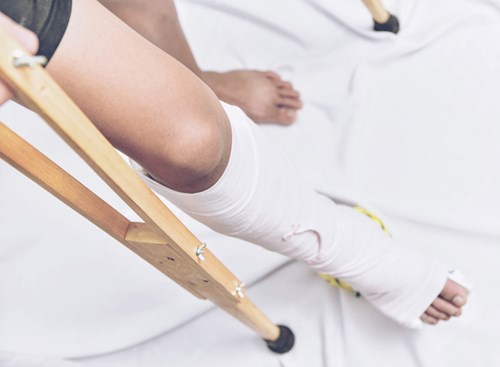
What are Shin Splints? A Breakdown of This Common Sports Injury
Chances are you’ve heard of or even experienced shin splints, but do you know what they are?
Shin splints are a common injury athletes and non-athletes alike experience due to stress on the connective tissues – muscles, tendons and bone tissue – that surround the shinbone.
This stress causes inflammation, which in turn causes pain that radiates up and down the front of the leg.
Because shin splints are so common, many don’t think twice when they develop pain following a long hike or after upping their exercise intensity.
However, experts say shin splints can develop into a bigger issue if proper treatment isn’t administered.
“Patients have been told not to worry about their shin pain while running and doing sports, often being told to push through the pain to continue training,” says Dr. Rachel Coel, a pediatric sports medicine physician with Kapiolani Medical Center for Women & Children.
Among her specialties is shin splints, a condition Coel says is often misunderstood.
“Many believe the pain from shin splints, at its worst, is just a muscle injury, but actually it may be a stress fracture. These can become quite serious – they are broken bones that need immobilization, rest, nutrition and planning for future prevention,” Coel explains. “Totally different ballgame, so awareness is key.”
Here, Coel provides a breakdown of this condition, plus the most common culprits behind shin splints and what to do if you experience this injury.

Let’s start with the most important question: What are shin splints?
Shin splints are a type of stress-related injury to the muscles that support the lower leg. They are part of a spectrum of injury to the lower leg, starting with shin splints and progressing to stress reaction of the shin bones, followed lastly by stress fracture of one of the shinbones, typically the tibia.
Shin splints are medically known as medial tibial stress syndrome and typically are caused by overuse stress injury, meaning an overload that causes too much stress to the muscles.
When this happens, the muscles begin to fail, not doing their job to absorb shock and support the bones and joints of the lower leg, which results in the bones carrying the load instead.
If this happens, the bone may start to swell and become inflamed, known as stress reaction.
If left untreated, shin splints and stress reaction can progress ultimately to stress fracture, which is when the bone can no longer handle the load being placed on it and it cracks.
A fracture means broken bone, so a stress fracture is truly a type of broken bone. In the case of shin splints, a fracture is caused by an overload of stress from impact, such as running or jumping.
We see this often in the tibia bone in cross country and track runners, basketball players and other athletes who participate in sports that involve a lot of running, but any sport that has a frequent and repetitive load (for example, ballet, gymnastics, soccer) can cause stress fractures.
A stress fracture has a longer and more-involved healing process than shin splints and can even require surgical treatment if the bone is not healing well.
For many athletes, especially female distance runners, stress fracture is due to a combination of physical overload and lack of calories (i.e., burning more calories than they are eating). Increasing their calorie intake and reducing the running often fixes the problem and prevents it from recurring.

What are the common causes of shin splints?
There are multiple causes but typically overuse, such as running too much too soon.
Think of a situation like this: A student shows up for the school cross country team and starts running 3 miles a day with the team without running all summer. This is a clear example of running too much too soon!
Also, poorly fitting or improper footwear, poor running or sports technique and any weakness, tightness or muscle imbalance all contribute to shin splints.
How can you tell if you have shin splints, versus another injury?
It’s very hard to tell, which is why it helps to have a sports medicine physician evaluate you.
Shin splints usually cause pain all over the shin – up and down the front of the shin – whereas a stress fracture is often point-tender at one spot.
However, it can be very difficult to tell, and often more workup is needed.
Sometimes the only way to tell is advanced imaging, such as X-ray or MRI.
Do shin splints usually occur in both legs, or can the condition develop in only one?
They can be one leg or both. I have had several patients with stress fractures in both legs at the same time.

Can you offer a few tips for preventing shin splints?
Ramp up gradually.
Start with mixing running with walking. For example, if you are just starting out running, run for five minutes, then walk for two minutes; repeat once. As you get stronger and faster, try running for longer stretches and shortening your walking intervals.
Take days off between runs and work in cross-training activities, like using the elliptical machine, riding a bicycle or running in a pool to give your leg muscles a break.
Also, make sure you have the proper shoes for your activity – DO NOT run in Vans or other ill-fitting, yet fashionable shoes!
Your shoes don’t have to cost $120 or be the top-of-the-line brand, but they should be made for running or the sport you are doing.
Most people will do fine with simple low-cost running shoes.
Many believe the pain from shin splints, at its worst, is just a muscle injury, but actually it may be a stress fracture. Totally different ballgame."
That being said, there are all types of running shoes now, some with very little support that rely on your natural foot structure and musculature to support you, while others have a lot of cushioning.
It’s important to try on shoes and go to a running shoe store to be fitted by a knowledgeable sales representative who can help you find the best shoe for your needs, your foot and style of running.
Very few people need orthotics in their shoes.
Stretching can be helpful, especially stretching of the hamstrings, quadriceps, calf muscles and foot arch.
Strengthening of the foot muscles can be helpful too. A few easy exercises to do at home can be picking up marbles with your toes, or pushing a dish towel around with your forefoot while keeping your heel on the floor.
If you begin experiencing shin pain while running or after running, apply ice and rest. Don’t push through a lot of shin pain.
Also, make sure you are eating well and eating enough calories to match what you expend with your tough workouts.
Eat plenty of healthy foods such as fruits, vegetables, whole grains, lean meats and seafood.
Are shin splints treatable? If so, do you have to see a doctor, or can they be treated at home?
Yes, shin splints are treatable.
It is often helpful to see a doctor knowledgeable in running (like a sports medicine physician!) who can make the correct diagnosis and help treat shin splints appropriately. This may include physical therapy, home exercises, orthotics, running technique instruction, sports nutrition guidance and shoe advice.
If you have a stress reaction or a stress fracture, you would need a walking boot and rest from running entirely, while shin splints would not require use of a walking boot.
If you have a stress fracture, you can plan to remain in the walking boot for approximately six weeks.

Is there anything you can do to reduce your risk for developing shin splints? If so, what?
You can reduce your risk of shin splits with:
- Getting the proper nutrition, such as eating enough of the right type of healthy calories to help fuel your body.
- Allowing your body to recover from strenuous workouts.
- Wearing the proper footwear for your sport or activity.
- Ramping up training gradually to prepare for your sports season well in advance to allow your body a chance to acclimate to the steadily increasing load.
- Stretching and strengthening the right muscles to support your running and jumping activities.
- Learning proper technique.
Anything else you’d like to add?
Acknowledging that shin splints is the first stage in a possibly more serious and dangerous set of injuries is important. Early diagnosis and treatment can prevent stress fractures.
Published on: August 8, 2019




